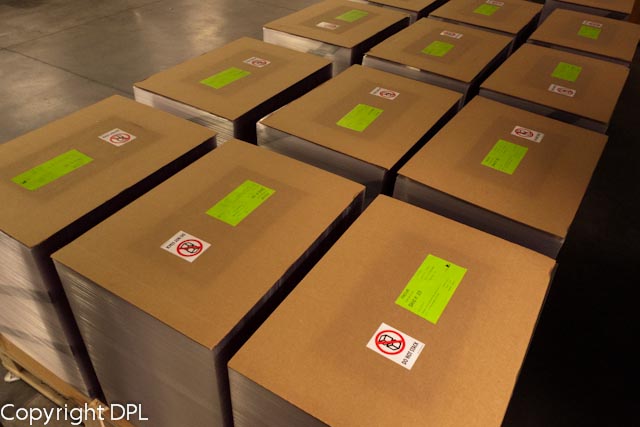PRE-PRINT
Conditioning lenticular materials
As with all plastic materials it is very important to make sure your lenticular plastic is ‘factory conditioned’ before going to press. This applies equally to both the offset and digital print processes.
Although all our lenticular materials are stored in a heated warehouse they can spend several days in transit on the way to your factory. During the winter months this can mean that the pallets are subject to extremely low temperatures. Therefore when the material arrives at your factory it must be allowed to ‘acclimatize’ or ‘condition’ before you make any attempt to pitch check, print or process the stock.
Non-acclimatized sheets will not process well. Cold materials may be more rigid and less pliable than ambient materials. This can lead to problems feeding through the press and will certainly cause colour-to-colour and print to sheet registration issues.
Depending on the time of year and the ambient temperature the time allowed for this conditioning will vary. During the warmer summer months it is advisable to allow the material to acclimatize in the pressroom for at least 24 hours before processing. During this time the pallets should be unwrapped and the strapping removed to allow the material ‘relax’. This will aid sheet feeding through the press. During winter months when the temperature during transportation can fall well below freezing it is advisable to allow at least 72 hours before beginning to process the sheets. Again the sheets should be unwrapped and stored in the pressroom with the strapping removed. Always check the temperature at the centre of the stack. Its probable that the outside edges will feel warm but the centre remains to cold to process.
STORAGE
Good storage practices should be followed such as keeping the material out of the elements and sunlight. Exposure to intense artificial lighting should also be avoided. The material should be kept dry and covered to minimize contamination.
Temperature and humidity variations should be kept to a minimum.
Ideal storage conditions are 24°C and less than 50% relative humidity.
Avoid sustained exposure to temperature extremes of 43°C or greater combined with high humidity.
This information is given with no expressed or implied guarantee or warranty that a material is suitable for use in a given application. No responsibility is accepted that this information is sufficient or correct in all cases. It is the responsibility of our customers to determine that their use of our product(s) is safe, lawful and technically suitable for their intended applications at time of use and prior to converting.










